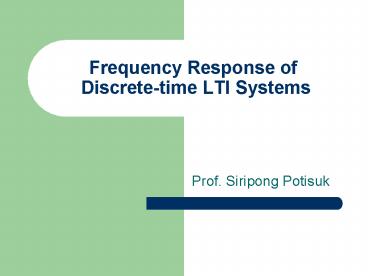Frequency Response of Discrete-time LTI Systems - PowerPoint PPT Presentation
Frequency Response of Discrete-time LTI Systems
Digital Frequency Effects of Pole & Zero Locations A zero at indicates that the filter will fully reject spectral component of input at Effects of a zero located ... – PowerPoint PPT presentation
Title: Frequency Response of Discrete-time LTI Systems
1
Frequency Response of Discrete-time LTI Systems
- Prof. Siripong Potisuk
2
For a discrete-time LTI system, the frequency
response is defined as
3
In terms of transfer function,
The frequency response is just the transfer
function evaluated along the unit circle in the
complex z-plane.
w
H(ejw) periodic in w with period 2p
1
4
Digital Frequency
X(ejw) is simply a frequency-scaled version of
X(jW)
- Normalization of the frequency axis so that W
Ws - in X(jW) is normalized to w 2p for X(ejw)
5
For H(z) generated by a difference eq. with
real coefficients,
6
For a given choice of H(ejw) as a function of w,
the frequency composition of the output can be
shaped - preferential amplification -
selective filtering of some frequencies
7
(No Transcript)
8
(No Transcript)
9
(No Transcript)
10
(No Transcript)
11
(No Transcript)
12
(No Transcript)
13
(No Transcript)
14
(No Transcript)
15
Ex. Consider a 2nd order digital filter with
Plot the magnitude and phase responses of the
system.
16
Effects of Pole Zero Locations
- A zero at indicates that
the filter - will fully reject spectral component of input
at - Effects of a zero located off the unit circle
depends on its distance from the unit circle. - A zero at origin has no effect.
- A pole on the unit circle means infinite gain at
that frequency. - The closer the poles to the unit circle, the
higher the magnitude response.
PowerShow.com is a leading presentation sharing website. It has millions of presentations already uploaded and available with 1,000s more being uploaded by its users every day. Whatever your area of interest, here you’ll be able to find and view presentations you’ll love and possibly download. And, best of all, it is completely free and easy to use.
You might even have a presentation you’d like to share with others. If so, just upload it to PowerShow.com. We’ll convert it to an HTML5 slideshow that includes all the media types you’ve already added: audio, video, music, pictures, animations and transition effects. Then you can share it with your target audience as well as PowerShow.com’s millions of monthly visitors. And, again, it’s all free.
About the Developers
PowerShow.com is brought to you by CrystalGraphics, the award-winning developer and market-leading publisher of rich-media enhancement products for presentations. Our product offerings include millions of PowerPoint templates, diagrams, animated 3D characters and more.































